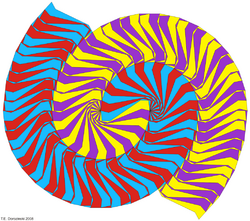Voderberg tiling

The Voderberg tiling is a mathematical spiral tiling, invented in 1936 by mathematician Heinz Voderberg (de) (1911-1945).[1] Karl August Reinhardt asked the question of whether there is a tile such that two copies can completely enclose a third copy. Voderberg, his student, answered in the affirmative with Form eines Neunecks eine Lösung zu einem Problem von Reinhardt ["On a nonagon as a solution to a problem of Reinhardt"].[2][3]
It is a monohedral tiling: it consists only of one shape that tessellates the plane with congruent copies of itself. In this case, the prototile is an elongated irregular nonagon, or nine-sided figure. The most interesting feature of this polygon is the fact that two copies of it can fully enclose a third one. E.g., the lowest purple nonagon is enclosed by two yellow ones, all three of identical shape.[4] Before Voderberg's discovery, mathematicians had questioned whether this could be possible.
Because it has no translational symmetries, the Voderberg tiling is technically non-periodic, even though it exhibits an obvious repeating pattern. This tiling was the first spiral tiling to be devised,[5] preceding later work by Branko Grünbaum and Geoffrey C. Shephard in the 1970s.[1] A spiral tiling is depicted on the cover of Grünbaum and Shephard's 1987 book Tilings and Patterns.[6]
References
- ↑ 1.0 1.1 Pickover, Clifford A. (2009). The Math Book: From Pythagoras to the 57th Dimension, 250 Milestones in the History of Mathematics. Sterling Publishing Company, Inc.. p. 372. ISBN 9781402757969. https://books.google.com/books?id=JrslMKTgSZwC. Retrieved 24 March 2015.
- ↑ Adams, Jadie; Lopez, Gabriel; Mann, Casey; Tran, Nhi (2020-03-14). "Your Friendly Neighborhood Voderberg Tile" (in en). Mathematics Magazine 93 (2): 83–90. doi:10.1080/0025570X.2020.1708685. ISSN 0025-570X. https://www.tandfonline.com/doi/full/10.1080/0025570X.2020.1708685.
- ↑ "Karl Reinhardt - Biography" (in en). https://mathshistory.st-andrews.ac.uk/Biographies/Reinhardt/.
- ↑ Voderberg, Heinz (1936). "Zur Zerlegung der Umgebung eines ebenen Bereiches in kongruente". Jahresbericht der Deutschen Mathematiker-Vereinigung 46: 229–231.
- ↑ Dutch, Steven (29 July 1999). "Some Special Radial and Spiral Tilings". University of Wisconsin, Green Bay. https://www.uwgb.edu/dutchs/symmetry/radspir1.htm.
- ↑ Grünbaum, Branko; Shephard, G. C. (1987), Tilings and Patterns, New York: W. H. Freeman, Section 9.5, "Spiral Tilings," p. 512, ISBN 0-7167-1193-1, https://archive.org/details/isbn_0716711931/page/.
External links
- Cye H. Waldman (9 September 2014). "Voderberg Deconstructed & Triangle Substitution Tiling". https://docplayer.net/154111976-Waldman-voderberg-deconstructed-9-september-voderberg-deconstructed-triangle-substitution-tiling-cye-h-waldman.html.
 |


